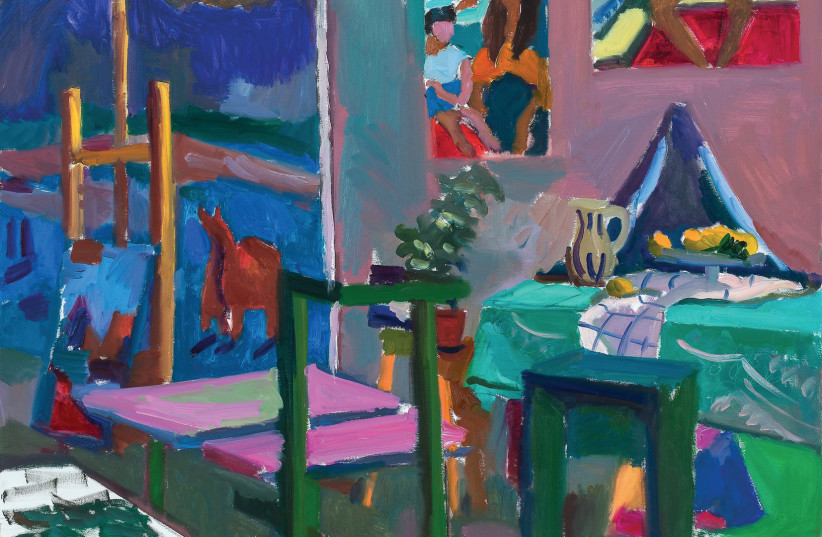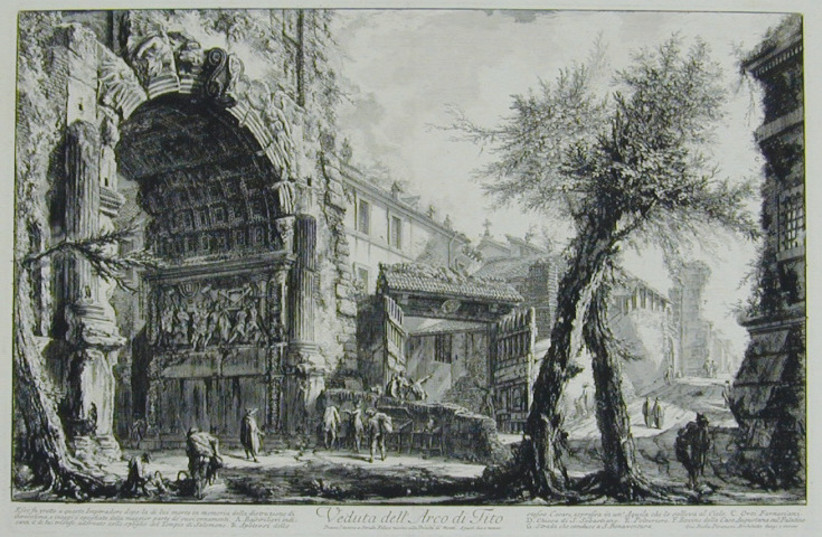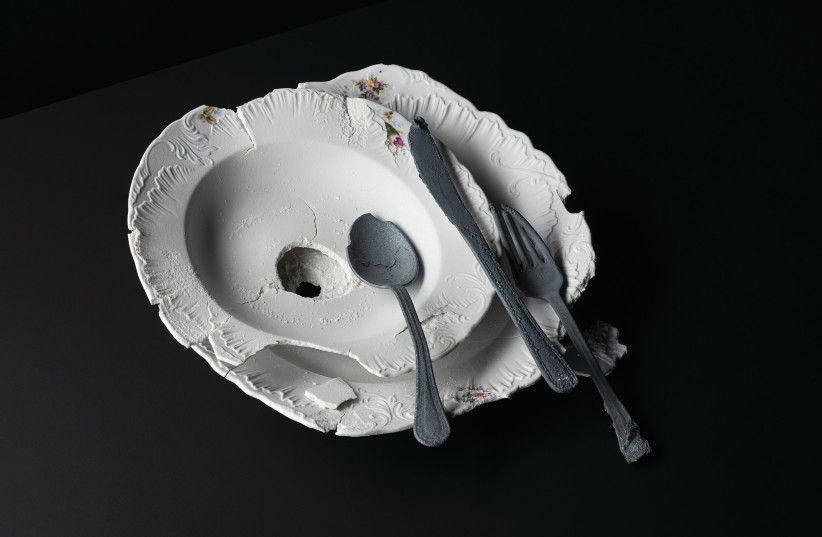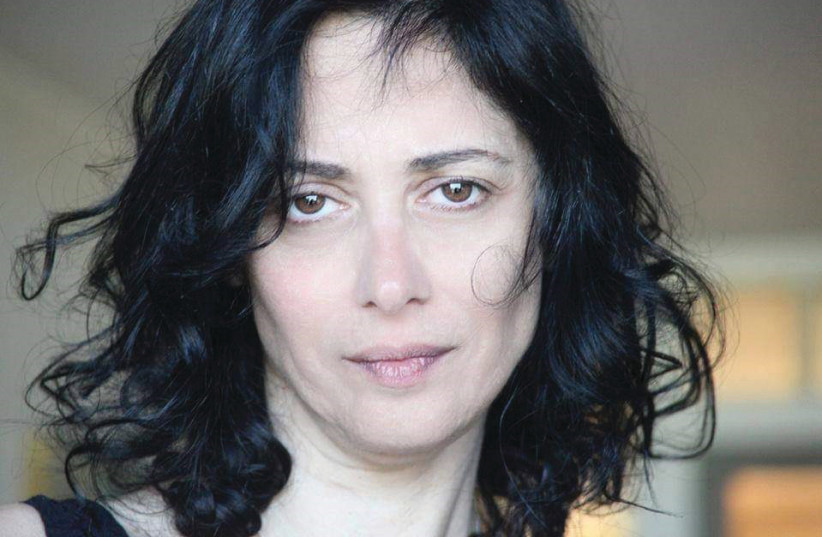One room at Haifa Museum of Art now contains nearly all locally-held works by important French painter Édouard Vuillard. A member of Les Nabis (the Prophets), an art group that sought to renew painting at the start of the 20th century, Vuillard’s paintings were joined to works by five current Israeli artists for At Home: Dwelling of Loves and Anxieties, a new exhibition created by the museum’s Chief Curator Kobi Ben-Meir. The artists are Tzion Abraham Hazan, Ira Eduardovna, Aram Gershuni, Uriel Miron, and Hilla Spitzer.
By linking Vuillard with, for example, Hazan’s 2019 art video Saluki, visitors are offered a unique opportunity. Hazan asked Kibbutz Be’eri members to describe an accident of friendly fire by the IDF that took place at Wadi Saluki, Lebanon. Shot at the Kibbutz dining hall, they began to use bits of food to represent the brief history they just read.
Art and the power of representation
The intrusion of violence and pain into orderly, neat surroundings is made possible due to the human ability to imagine and represent one thing using another. Beetroot soup becomes blood, and matches become steps.
Similarly, Vuillard explored paint and how its materiality might be used to represent more than just the objects painted. A skilled theater set designer, it is interesting to wonder what he would have thought of this video art.
In another gallery, Natalia Zourabova lives in painting. Born in the USSR, Zourabova was one of the founders of the New Barbizon School. A group of women painters, all Russian speakers, opted to explore what figurative painting might offer within an Israeli context.
“She lives and works at the same place, so painting and reality mix together,” Ben-Meir told The Jerusalem Post, “she is a painter whose theme is painting, not her biography or the location she is at.” The depiction of still life, interiors, and the people with whom the artist lives – the women Vuillard paints or Oded, a recurring figure in Zourabova’s works – are part of a vast shift in art history from sacred and mythological scenes, think crucifixions and Greek gods, painted on large canvases for wealthy patrons – to smaller paintings of still life sold to an emerging middle class. Zourabova is a bold artist, unafraid to give us excellent paintings on a large scale.
Standing in front of her painting Seven, a visitor might turn to the left to enjoy Haifa’s harbor or look to the right to see the Hadar neighborhood. This is a wonderful nod to the building’s history, which once served as a school. Its windows were sealed when it was turned into a museum to protect the works from sunlight. The restoration of these glass panel “eyes” to the city outside, done roughly two and a half years ago, meant gaining a higher awareness of the city. By using advanced technology, these windows block any harmful effects the light might cause the paintings shown.
One floor below, one can enjoy another massive painting, the masterful 1956 work Unemployment Bureau by Gershon Knispel, included in Northern Wind – Israeli art from the Museum’s Collection. This painting is shown near another work, Refugees Waiting for their Return, a 2018 painting by Abed Abdi. Abdi was a friend of the late Knispel, and the two worked together to create the 1978 Land Day Monument in Sakhnin.
Piranesi: Views of Rome is the final course in this elaborate artistic banquet. Giovanni Battista Piranesi was a great archeologist and etcher. His works allowed anyone to see the Eternal City by picking up a copy of his prints during the 18th century. Visitors will be able to see a 1771 depiction of The Arch of Titus and admire the unparalleled manner in which Piranesi depicted the majesty of Rome while also offering a very human meditation of how all glory fades.
Just as Vuillard might relinquish a precise backdrop to offer emotion, Piranesi offers faded pillars presented against a jumbled perspective in which the old stone gods are semi-broken, the city overrun with plants, and semi-naked tiny people – those who live in the Rome of his own time – do what they can after the destruction. “One of our guiding principles,” Ben-Meir concluded, “is to offer solace through beauty. Beauty in its deep meaning, as a material object which contains meaning.”
A short walk from the museum is another group exhibition at the Wizo Academy of Design. The 4th Mediterranean Biennale was curated by Belu-Simion Fainaru under the title Anybody Home? Thirty artists, Israelis and foreign, present their works at five additional locations across Haifa. Surprising links can be made between the choices Ben-Meir made and those Fainaru made. It seems a feeling of dread, that the interior spaces we live in are no longer safe, is common to both exhibitions.
In his 2013 work Soundtrack, shown at Wizo, Guy Ben-Ner resumes his depiction of his private home and family in outrageous, funny contexts. In this work, the soundtrack from the 2005 film War of the Worlds is played within the domestic scene. The invading aliens and the American cultural jokes about whether “alien” means a person from Europe – catch a very different meaning.
In another video artwork titled Fossils, Shahar Marcus and Nezaket Ekici hold hands and lay down to be buried under rocks together. This moving performance, seeing as one is an Israeli artist and the other is a Turkish artist, speaks volumes in the current cultural climate, where Israeli artists are confronted with bias almost everywhere.
Haifa Museum of Art is located at 26 Shabtai Levy Street. All exhibitions were curated by Ben-Meir and are on display until Saturday, June 29. Call (04) 603-0800 to learn more. WIZO Academy of Design is at 21 Haganim Street and will be on display until Thursday, March 7. For more information, visit https://mediterraneanbiennale.com/en/.
New in Tel Aviv
DISINTEGRATION – Polish-born Jewish ceramics master Marek Cecula returns to Israel after curating the 3d Biennale of Israeli Ceramics at the Eretz Israel Museum a decade ago, to offer us a peek into his own works. Born in Kielce, Poland, Cecula returned to the city of his birth and is currently working with the Cmielów porcelain factory. The porcelain sets Cecula creates are highly personal, bent and cracked in ways to make them unserviceable but also eerily pretty.
Visitors might see this as a deeply Jewish reflection on losses during the Holocaust or as a very current take on how things once offering comfort and stability refuse to carry on doing so. Curated by Shlomit Bauman, this Beit Benyamini Contemporary Ceramics Center exhibition is on display until Saturday, April 14, at 2 p.m. at 17 Haamal Street. Contact (03) 5182257 to learn more.
SLEEPERS – Those exiting King Saul’s (Shlomo Hamelech) Boulevard light rail station will encounter a new public artwork. Two massive metal cats napping on two huge stone cubes. The words ‘Yes’ and ‘No’ were carved into both blocks in Hebrew and English. Created by Yael Frank, the work follows an earlier piece she created in 2021 called Salami.
Shown at the Herzliya Museum of Contemporary Art, Salami was composed of the Hebrew word for Peace and turned into a giant feline playground. The work is ironic; cats are not aware of what Shalom means, and their motivation is territorial. “We share such a small and charged space here, so there might be an Israeli bridge and below it a Palestinian road, and below that a tunnel, and above that airspace,” she told Portfolio Magazine. For Frank, this was like a cat-oriented playground which often invite cats to climb up to assert control of “their” space.
Sleepers is such a delight because it invites us to ask more. These binary options are exactly the same: a cat sleeping on a cube, so what real choice is offered to us? Who are the sleepers? Are they the felines or the people who go on about their everyday lives while the Hamas-held hostages are still trapped in Gaza and the war rages on?
This is but one out of 30 new public artworks now being installed in the city. The new works will join the existing 184 public sculptures, and the new collection will be cataloged. This effort was led by Tel Aviv Mayor Ron Huldai, who was reelected this week.
Other art news from around the country
MOON ART – Lali Michaeli is the first, and only, Hebrew poet to have her work placed on the moon. Selected to the Lunar Codex, four-time capsules which – together – encompass 35,000 different artists and writers from 233 countries – Michaeli’s poem My Mom was preserved in a nickel and gold coin using NanoFiche technology. These coins, containing Inuit art and the spoof digital sci-fi magazine Gravity City, and an homage to The Mets baseball team titled Moonstruck – were placed on the moon on Thursday, February 22, by Intuitive Machines. Their Nova-C lander, nicknamed Odie (for Odysseus), was flown to the moon on a SpaceX Falcon 9. This mission marks America’s return to the moon, and its cultural aspects are meant to inspire further human exploration of it.
This is not the first time humanity has sent art to the moon. The Apollo 12 mission included an unauthorized ceramic wafer with six drawings left there in 1969. Called Moon Museum, it included drawings by Andy Warhol, Robert Rauschenberg, and Forrest Myers.
Art Roundup is a monthly glance at some of the finest art exhibitions and events currently shown across the country. Artists, curators, and collectors are welcome to send pitches to hagay_hacohen@yahoo.com with “Art Roundup” in the email subject.
















